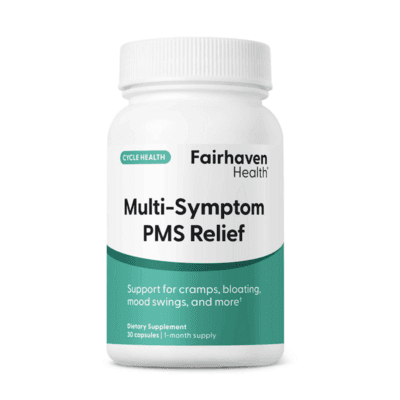Multi-Symptom PMS Relief
Fairhaven HealthAlready have an account? Log in

Description
Advanced Support for Relief From Multiple Premenstrual Symptoms*
Multi-Symptom PMS Relief is a next-generation, triple-action PMS formula designed to help balance hormones, support neurotransmitter function, and promote healthy inflammatory balance for physical, mood-related, and cognitive symptoms of PMS (1) in a single, once-daily capsule.*
Clinically Studied Ingredients
Multi-Symptom PMS Relief contains scientifically researched ingredients that work cross-functionally as triple-action support for hormonal balance and cycle health, neurotransmitter balance and mood support, and inflammation support to provide physical symptom relief.(1)
- Vitex (chasteberry) supports reproductive hormone balance and prolactin, which may help with breast tenderness, water retention, and PMS-related mood symptoms.*(2)
- 5-HTP supports healthy sleep cycles and plays a key role in mood, emotional resilience, and satiety.*(3-5)
- Copaiba extract supports emotional balance and stress resilience and helps balance the HPA and HPG axes, which play key roles in cycle health and PMS symptom severity.*(6,7)
- B vitamins (B6, B12, methylated folate) help to support mood balance and mental clarity, along with fatigue and stress.*(4,8,9)
- CoQ10 helps to promote hormone production and counteracts PMS-related fatigue.*(10,11)
- Magnesium support for cramping, bloating, and pain perception, while vitamin D works with magnesium to support calcium absorption for mood balance.*(14,15)
Clean, Vegetarian Formulation
Multi-Symptom PMS Relief is made without gluten, dairy, yeast, soy, artificial colors, or preservatives. It's manufactured in the USA using domestic and imported ingredients in a GMP-registered manufacturing facility.
Packaging and label may vary.
References:
1. Gudipally PR and Sharma GK. Premenstrual Syndrome. StatPearls Publishing; 2025.
2. Girman A et al. Am J Obstet Gynecol. 2003;188(5):S57-S65.
3. Turner ET et al. Pharmacology & Therapeutics. 2006;109:325-338.
4. Amin Z et al. Behavioral and Cognitive Neuroscience Reviews. 2005;4(1):43-58.
5. Wurtman et al. Obes Res. 1995;3(Suppl 4):477S-480S.
6. Scandiffio R et al. Nutrients. 2020;12:3273.
7. Hashiesh HM et al. Biomedicine & Pharmacotherapy. 2021;140:111639.
8. Bottiglieri T. Topic in Clinical Nutrition. 1996;54(12):382-390.
9. De Souza MC et al. Journal of Women’s Health & Gender-Based Medicine. 2000;9(2):131-139.
10. Mantle D et al. Antioxidants. 2023;12:514.
11. Tsai I et al. Front Pharmacol. 2022;13:883251.
12. Fathizadeh N et al. IJNMR. 2010;15(Special Issue):401-405.
13. Boyle NB et al. Nutrients. 2017;9:429.
14. Uwitonze AM et al. J Am Osteopath Assoc. 2018;118(3):181-189.
15. Arab A et al. Int J Prev Med. 2020;11:156.
Suggested Use / Directions:
Take 1 capsule daily, or as directed by your healthcare practitioner.
Serving Size:
1 Capsule
Amount Per Serving:
Vitamin D (as cholecalciferol) ... 12.5 mcg
Vitamin B6 (as pyridoxine HCl) ... 25 mg
Folate (as L-5-methyltetrahydrofolic acid) ... 600 mcg DFE
Vitamin B12 (as methylcobalamin) ... 50 mcg
Magnesium (as magnesium oxide) ... 120 mg
Chaste Tree Extract (Vitex agnus-castus, fruit, standardized to 0.5% agnusides) ... 200 mg
Copaiba Extract (Copaifera officinalis, oleoresin, standardized to 10% β-caryophyllene) ... 70 mg
Coenzyme Q10 ... 50 mg
5-Hydroxytryptophan (5-HTP) ... 50 mg
Other Ingredients:
Vegetarian Capsule (Cellulose), Rice Bran Lipid, Silica.
Take only as directed. Consult your healthcare practitioner before use.